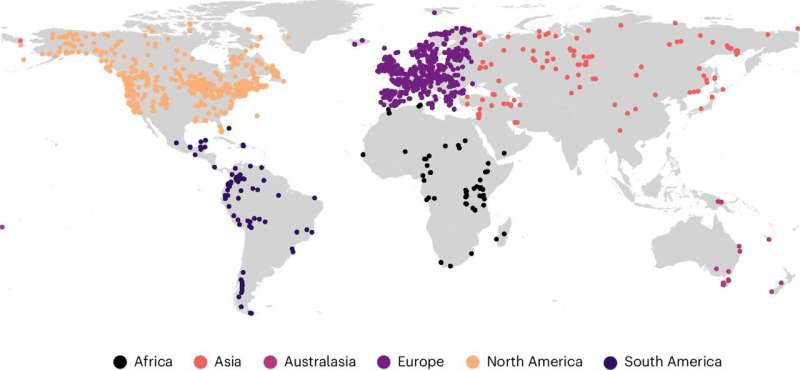This article has been reviewed according to Science X's editorial process and policies. Editors have highlighted the following attributes while ensuring the content's credibility:
fact-checked
peer-reviewed publication
trusted source
written by researcher(s)
proofread
The first farmers often made landscapes more biodiverse, providing lessons for rewilding today

You don't need to read the news or scroll through Instagram for long to stumble across the latest example of a rare and beautiful species that has gone extinct. Since AD1500, at least 705 vertebrate species and 571 plant species have died out.
Humans have now appropriated over half of the Earth's surface for farms and urban areas, and this is primarily to blame for these recent declines in global biodiversity.
But humans didn't suddenly appear in the year 1500. Early humans were burning the African savannahs from about 400,000 years ago, and possibly much earlier.
There is evidence that Neanderthals altered the plants and landscapes of Europe about 125,000 years ago. And while there is still some debate, humans were probably the decisive factor in the extinction of most of Earth's once-widespread megafauna over the past 100,000 years.
Then, about 12,000 years ago, the most recent ice age ended and a new geological unit of time, known as the Holocene, began. This marked a major shift in human-environment relationships, as people independently transitioned from foraging to farming in many different places around the world.
Whether this transition looked like rice paddies in China, wheat fields in the Levant or maize and squash production in Mesoamerica, humans were modifying the landscape more and more. Domesticated livestock soon followed in many places.
All this had a surprising impact on biodiversity. Our latest research shows farming and other human-driven ecosystem changes increased diversity as often as they reduced it.
Fossil pollen tells us about past vegetation
To reconstruct how vegetation has changed over many thousands of years, scientists look at fossilized pollen grains contained in layers of sediment and organic matter (such as decomposed twigs and leaves) in places like peat bogs and lakes. The timing of layers and variety of pollen found create a picture of the changing diversity of plant species through time in the local landscape.
Analyzing pollen data from the Neotoma Paleoecological Database, we found that plant communities became increasingly diverse across most of the northern hemisphere over the Holocene, starting around 9,000 years ago in Europe. Surprisingly, these increases in diversity are often linked to growing levels of human activity.
In the southern hemisphere, the results are more varied. In Africa and South America, increased human land use saw decreases in plant diversity, and reduced land use saw an increase in diversity. Despite this, the turnover rate—how quickly different types of plants change—increased with human land use in all of the continents. Humans have been a key driver of vegetation change for a very long time.
Farming created a patchy landscape
Following the end of the last ice age, the climate warmed, conditions generally became a bit wetter, and forests spread across newly thawed lands—particularly in the northern hemisphere. It is in these expanded, early-Holocene forests where we find the strongest overall links between an increasing human presence and the increased diversity of plants over the Holocene.
In contrast, in open and grassy locations such as the North American great plains and the savannas of Africa, plant diversity decreased as human pressures grew.
The link is best illustrated in Europe, where two large increases in plant turnover and biodiversity found in pollen samples roughly coincide with the two major migrations of people into Europe over the Holocene.
The first began around 9,000 years ago with the north and westward movement of Neolithic (farming) populations from the Fertile Crescent region of the Middle East into Europe. The second began around 5,000 years ago during the early Bronze Age, as horse-riding pastoralists from the central Asian steppe—the Yamnaya—moved westward into Europe.
We think these new arrivals in Europe would have chopped down some, but not all, of the forests to make way for animals and crops and to make their homesteads. Grasses and other plants that thrive in disturbed ground would have moved in. This would have created a diverse landscape full of patches of different vegetation.
Making a forest patchy is easier than making an open grassland patchy, since it's easier to chop down trees and for open-ground plants to colonize these gaps. Making an open, grassy location patchy means planting trees (and them surviving) in places that are too dry or cold to support tree growth. We believe the fact it is easier to make a forest patchy could have driven some of the historical differences in patterns of vegetation between different parts of the world.
Land without people may have less biodiversity
Many people today advocate for enhancing biodiversity by minimizing the human influence on landscapes. Often this takes the form of rewilding, which aims to "let nature lead."
Yet our results suggest that in many places—though not all—minimally human-modified landscapes had fewer different types of plants. Often, human disturbances enhanced rather than eroded biodiversity. Indeed, many of Europe's most biodiverse places today are traditionally managed, low-intensity farmlands such as Alpine meadows and the dehesas and montados in Spain and Portugal.
In light of this, removing humans from landscapes to make ecosystems healthier and more diverse could sometimes be counterproductive. Though perhaps surprising, our research reveals that in many places, biodiversity thrives because of, not despite, thousands of years of human interactions with the Earth's ecosystems.
Journal information: Nature Ecology & Evolution
Provided by The Conversation
This article is republished from The Conversation under a Creative Commons license. Read the original article.![]()


















